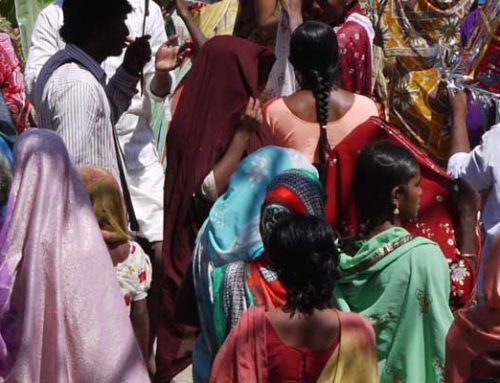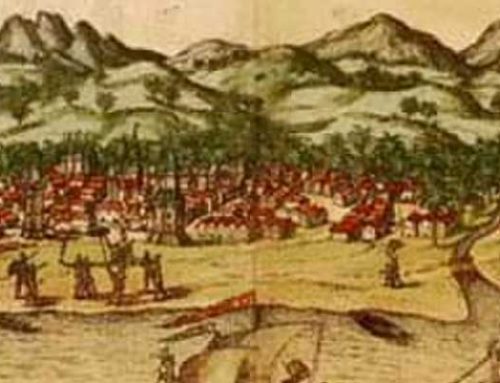By 326BCE, India was a land of many languages and cultures. Hindu rajas ruled small but often rich kingdoms. The wealth of the rajas attracted the army of Alexander the Great, a young Greek general who amassed the largest empire of his era.
Shortly after Alexander’s death in 323BCE, a young soldier of a low caste named Chandragupta Maurya led a rebellion that drove out the Greek invaders. By 305BCE, Chandragupta’s Mauryan Empire stretched from the Bay of Bengal in eastern India across the northern portion of the subcontinent through the Hindu Kush into modern-day Afghanistan. For the first time, one state ruled most of the subcontinent.
It was not the size of India but rather its cultural diversity that made the Mauryan Empire difficult to govern. To make his empire more easily managed, Chandragupta divided it into smaller regions called provinces—each ruled by a prince and his royal family. Chandragupta’s administration of the provinces was so efficient that later conquerors of India kept parts of his system intact for centuries.
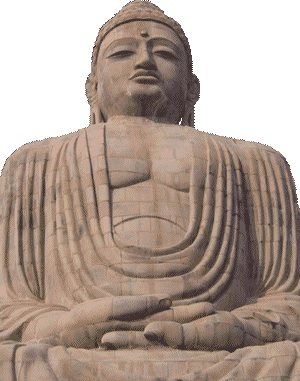
Ashoka
Ashoka (304–232BCE) was an Indian emperor of the Maurya Dynasty who ruled almost all of the Indian subcontinent from 269to 232BCE. Ashoka began his reign as a fierce warrior, but after a spiritual transformation, came to understand the destructiveness of his wars.
Chandragupta skillfully controlled his vast realm. He employed spies who provided him with secret reports on events in the provinces. He slept in different beds every night, and his servants tasted his meals for poison.
Later in his life, Chandragupta Maurya sought enlightenment by becoming a Jain. Jainism is an ancient Indian philosophy that combines elements of Hinduism and Buddhism. Jainism and Buddhism were popular with Indians who—like Chandragupta—had no status in the caste system. Legends tell us that Chandragupta eventually gave up his power and lived the last years of his life as an ascetic—a holy person who has given up all material pleasures and comforts.
Ashoka was Chandragupta’s grandson and a ferocious warrior. Upon the death of his father, Ashoka is believed to have massacred his brothers and sisters to seize control of the Mauryan Empire.
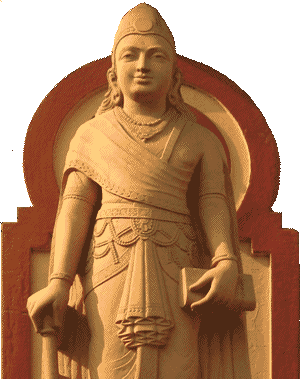
Chandragupta Maurya
Chandragupta Maurya (340BCE – 298BCE) was Ashoka’s grandfather and the founder of the Mauryan Empire. Chandragupta was the first emperor to unify India into one state. He ruled for twenty-four years beginning in 322BCE.
Once in power, Ashoka built an elaborate palace filled with flowers, trees, and ornaments. Deep inside the palace, however, was a torture chamber where the emperor imposed cruel punishments upon anyone who challenged his authority.
Ashoka’s army defeated the rival kingdom of Kalinga, but thousands of soldiers on each side were killed in the violent battle. Finally, as Ashoka rode out to the battlefield to rejoice in his last and greatest victory, he felt great remorse at the suffering he caused.
The emperor then had a spiritual transformation. He renounced war and became a devout Buddhist. He practiced ahimsa, the belief that one should not hurt any living thing. For the rest of his life, Ashoka refused to eat meat and banned all animal sacrifices.
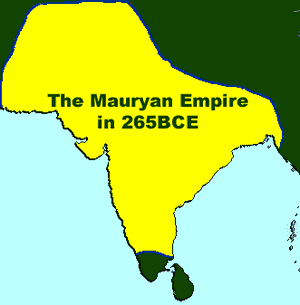
Mauryan_Empire_map
The era of Maurya Empire was first time most of the subcontinent had been united under one ruler. At its greatest extent, the empire stretched to the north along the natural boundaries of the Himalayas, and west to modern day Pakistan and east to what is now known as Assam.
Ashoka built Buddhist shrines and temples throughout Asia. The emperor sent Buddhist missionaries to foreign lands to share their beliefs. Buddhism is no longer widely practiced on the Indian subcontinent but is now a major influence in China, Japan, and Southeast Asia.
Ashoka spent the next forty years of his rule emphasizing human charity and respect for all living things. He ignored the caste system and insisted that all of his subjects be treated as equals. He sent engineers to build roads that encouraged people to travel and trade. The engineers also dug wells and built hospitals in poor villages.
Most of what we know about Ashoka’s rule comes from stone pillars he erected throughout his empire. The writings on some of the pillars espoused Buddhist principles, while others told the story of the Mauryan Empire. Many of the monuments have survived more than 2200 years to the present day.
The emperors who followed Ashoka were weak. After the emperor’s death, Hindu priests once again reimposed the caste system as the Mauryan Empire gradually shrunk. In 185bce, the last of the Mauryan rulers was killed, ending the empire that united most of the subcontinent.
Resources
Download this lesson as Microsoft Word file or as an Adobe Acrobat file.
Lexile Measure 1110L
Mean Sentence Length 16.18
Mean Log Word Frequency 3.32
Word Count 631
Mr. Donn has an excellent website that includes a section on India.

Pillar_of_Ashoka
Stone pillars were erected during Ashoka’s reign that espoused Buddhist principals, and told the story of the Mauryan Empire. Nineteen monuments have survived more than 2200 years to the present day.


